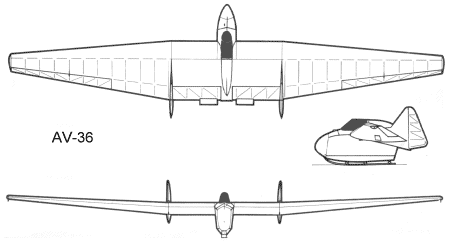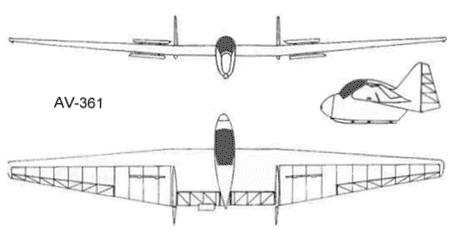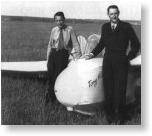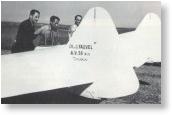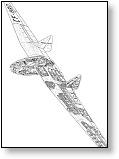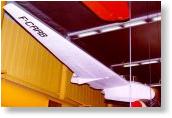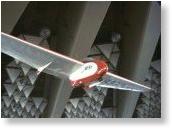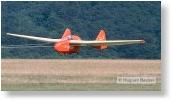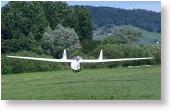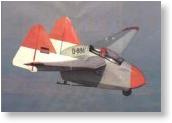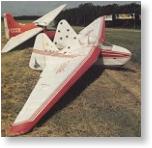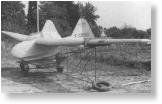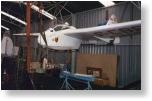| http://www.survol.cjb.net |
|
|
|
|
AV-36 / AV-361
Encouraged by his experience with the acceptance of his previous glider prototypes, Charles Fauvel created the AV-36 in 1951. This retained the characteristic silhouette further improved with the fuselage reduced to a minimal profile (limited almost to the pilot’s cockpit), with a short wing span (11.95 meters) and a diminutive empty weight (120 kg). The AV-36 wing as originally designed could not be disassembled. The wing was constructed of only one piece and transporting the AV-36 by road could be done merely by folding the two rudders against the trailing edge and removing the nose of the fuselage. The AV-36 could then be put on a trailer, the resulting width of 2.38 meters not being more than the allowable road width. Furthermore, this compactness made for a very strong structure and the wing was calculated not to fail until exceeding 12 G’s at 215 kg.
The prototype of the AV-36, constructed by Charles Fauvel and his son, made its first flight December 31, 1951 demonstrating its outstanding flight qualities immediately along with excellent longitudinal stability. The aircraft earned its French Navigability Certificate quickly, then shortly after came the Canadian certificate and the German certificate (the last officially allowing simple acrobatics). Some fifty examples were constructed by the Wassmer society, in Issoire. This establishment offered subsets (called kits today) for the receiving aeroclubs to assemble. Several were constructed under license in Germany, and many more built not only by amateurs in France, but also in Canada, England, Germany, Brazil and in Italy.
The AV-36 had performance very comparable to other gliders of the era with the advantage of being structurally simpler, stronger and less costly. Many pilots achieved roundtrip distance flights of 500 kilometers. In June 1954, Eric Nessler, the very famous French glider pilot who was a strong supporter of the Fauvel type, participated in the Paris-Biarritz race flying the AV-36. In 1957, Claude Visse earned his FAI Gold Badge in the AV-36.
In spite of strong criticism from detractors of the Fauvel flying wing formula, based more on prejudices rather than on the real facts, there existed in 1966 about a hundred AV-36 and AV-361 gliders. The AV-361 whose prototype flew in 1960 was an improvement of the AV-36. This version distinguished itself with a longer wing span (12.78 meters), aerodynamic wing improvements (of Hoerner type), reworked vertical surfaces and installation of perforated Schempp-Hirth type air brakes on top and bottom of the wing. The fuselage was made with a more oval, comfortable shape and a plexiglas bubble canopy permitted a more panoramic view. A nose tow hook replaced the two tow line attachments under the wings. Finally, control input had been modified for more aileron differential, providing better control harmony and less adverse yaw during turns. These changes resulted in an increased glide ratio (L/D) of 2 points, and a reduction in the sink rate of 6 cm/sec. Many of the AV-36’s built were equipped with the improvements that were later incorporated in the model AV-361, notably in Germany. Some German amateur builders went even farther by motorizing the AV-36 with the addition of a small pusher 2-cycle engine and a folding propellor at the rear of the short fuselage located between the dual rudders.
The last perfecting of this design version was the changing of the wing airfoil to the Wortmann Laminar FX-66 HS 159 instead the original Fauvel F4. The result was a glide ratio (L/D) of 30 at 85 km/h.
Today, there are still some active AV-36 and AV-361 flying wing gliders in France. It is interesting to note that at least one of them has been transformed into an ultralight motorglider (ULM in France) by the addition of a Koenig 2-cycle pusher engine of 24 Horsepower (like the German versions and the model AV-45) and a tricycle landing gear. In Canada, Falconar Avia Inc. of Edmonton, Alberta still sells plans for the AV-361 (English version) as well as some parts as a kit for amateur builders. In France, neither plans nor kits have been available since the death of Charles Fauvel in 1979.
| Characteristics and performance of the AV-36 and AV-361 | ||
| (S.I units) | AV-36 | AV-361 |
| Wing span | 11.95 m | 12.78 m |
| Length | 3.17 m | 3.24 m |
| Wing area | 14.20 m2 | 14.60 m2 |
| Airfoil | Fauvel F4 17% | Wortmann
FX-66 H 159 (optional) |
| Aspect ratio | 10 | 11.4 |
| Empty weight | 120 kg | 134 kg |
| Max. gross weight | 225 kg | 258 kg |
| Stall speed | 58 km/h | |
| Max. speed | 180 km/h | 180 km/h |
| Glide ratio | 26:1 at 83 km/h | 30:1 at 85 km/h |
| Sink rate | 0.87 m/sec | 0.74 m/sec |
